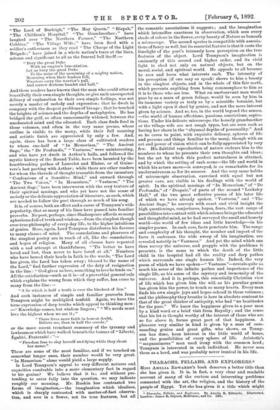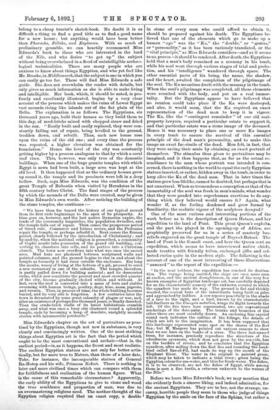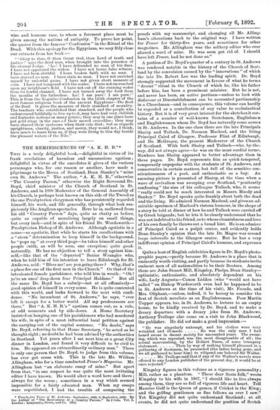PHARAOHS, FELLAHS, AND EXPLORERS.*
Miss AMELIA EDWA.BDEI'S book deserves a better title than she has given it. It is, in fact, a very clear and readable account of many of the curious and interesting problems connected with the art, the religion, and the history of the people of Egypt. Yet she has given it a title which might • Pharaohs, Pellxhs, and Explorers. By Amelia B. Edwards. Illustrated. London : James R. Osgood, Idellvaine, and Co. 1801. belong to a cheap tourist's sketch-book. No doubt it is as difficult a thing to find a good title as to find a good name for a new house ; but anything would have been better than Pharaohs, Pellahs, and Explorers. With so much of preliminary grumble, we can heartily recommend Miss Edwards's book to those who are interested in the land of the Nile, and who desire "to get up" the subject without being overwhelmed in a flood of unintelligible archaeo-
logical technicalities. There are many people who are anxious to know about things Egyptian, and who yet feel like
Mr. Brooke, in Middlemarch, that the subject is one in which you
can easily go too far. These will find Miss Edwards a safe guide. She does not overwhelm the reader with details, but only gives as much information as she is able to make living and intelligible. Her book, which, it should be noted, is pro- fusely and excellently illustrated, begins by a very clear account of the process which makes the ruins of Lower Egypt vast mounds rising like islands out of the flat plain of the Delta. The explanation is as follows. The Egyptians, six thousand years ago, built their houses as they build them to this day, of mud-bricks mixed with chopped straw and dried in the sun. " Easily built and easily replaced, they were con- stantly falling out of repair, being levelled to the ground, trodden down, and rebuilt. Thus, each new house rose upon the ruins of the old one; and every time the process was repeated, a higher elevation was obtained for the foundation." Hence the level of the city was constantly getting higher by a process analogous to that by which a coral reef rises. This, however, was only true of the domestic buildings. When one of the huge granite temples with which Egypt is sown had been built, a large area was kept at the old level. It thus happened that as the ordinary houses grew up round it, the temple and its precincts were left in a deep hollow. Such, says Miss Edwards, was the condition of the great Temple of Bubastis when visited by Herodotus in the fifth century before Christ. The final stages of the process by which the mounds of the Delta were created, may be given in Miss Edwards's own words. After noticing the building of the stone temples, she continues :-
" We have thus far traced the history of our typical mound from its first rude beginnings to the apex of its prosperity. As time goes on, however, and the last native Dynasties expire, the trade of the community languishes, the population dwindles, and the temple falls out of repair. Then comes the prosperous period of Greek rule. Commerce and letters revive, and the Ptolemies repair the temple, or perhaps rebuild it. Next comes the Roman period, closely followed by the introduction of Christianity ; and by-and-by, when the national religion is proscribed, a community of Coptic monks take possession of the grand old building, con- verting its chambers into cells, and its portico into a Christian church. The town now overflows into what was once the sacred area. Mud huts are plastered between sculptured walls and painted columns, and the ground begins to rise in and about the temple as formerly it had risen outside the enclosure. Ere long the monks, weary of living at the bottom of a pit, proceed to erect a new monastery in one of the suburbs. The temple, therefore, is partly pulled down for building material; and its desecrated ruins, which now constitute the poorest and most crowded quarter of the city, become gradually choked within and without. At last, even the roof is converted into a maze of huts and stables swarming with human beings, poultry, dogs, kine, asses, pigeons, and vermin. Thus, in process of time, the whole building becomes buried, and its very site is forgotten. A few centuries later the town is devastated by some great calamity of plague or war, and, after an existence of perhaps five thousand years, is finally deserted. Then the crude-brick shells of its latest habitations crumble away, and what was once a busy city clustered round a splendid temple, ends by becoming a heap of desolate, unsightly mounds strewn with innumerable potsherds."
Miss Edwards's chapter on the art of portraiture as prac- tised by the Egyptians, though not new in substance, is very clearly and convincingly written. One of the most striking things about Egyptian art is the fact that the period which ought to be the most conventional and archaic—that is, the earliest period—is, as it happens, the freest and most realistic. The earliest Egyptian statues are not only far better artis- tically, but far more true to Nature, than those of a later date. Take, for instance, the incomparable statues of General Ra-Hotep and his wife, Princess Nefert. There is nothing in later and more civilised times which can compare with them for faithfulness and realisation of the human figure. What is the cause of this remarkable circumstance P Apparently, the early ability of the Egyptians to give to stone and wood the true semblance and proportion of man, was due to an overmastering religions need. The mother-thought of the Egyptian religion required that an exact copy, a double in stone of every man who could afford to obtain it, should be prepared against his death. The Egyptians be- lieved that one of the elements which go to make up a.
human "ego" was the "Ka," the "double," or "genius," or "personality," as it has been variously translated, or the " vital principle," as Miss Edwards considers—and as it seems
to us, proves—it should be rendered. After death, the Egyptians held that a man's body remained as a mummy in his tomb, while his soul went through various stages of trial and proba- tion, and his " intelligence " wandered through space. The other essential parts of his being, the name, the shadow, and the heart, awaited the completion of the pilgrimage of the soul. The Ka meantime dwelt with the mummy in the tomb. When the soul's pilgrimage was completed, all these elements were reunited with the body, and put on a real immor- tality. But the Egyptians appear to have believed that no reunion could take place if the Ka were destroyed, and also, it would seem, that the Ka required an exact representation of the dead man to keep it in vigour. The Ka, like the " contingent remainder " of our old real- property lawyers, required a particular estate to support it, and that particular estate was a stone image of the deceased. Hence it was necessary to place one or more Ka images in every tomb to ensure the survival of this essential principle of the dead man's personality, and to make this image an exact fac-simile of the dead. Men felt, in fact, that they were saving their souls by obtaining an exact portrait of themselves. The stimulus thus given to portraiture may be imagined, and it thus happens that, as far as the actual re- semblance to the man whose portrait was intended is con- cerned, there is nothing in the world to equal the early Egyptian statues inserted, or rather, hidden away in the tomb, in order to keep alive the Ka of the dead man. That in later times the statues grow less lifelike, cannot be doubted, but perhaps that is not unnatural. When so tremendous a conception as that of the immortality of the soul was fresh in men's minds, what wonder that they were goaded into superhuman exertions to do any- thing which they believed would ensure it P Again, what wonder if, as the feeling deadened and grew formal by familiarity, the realistic vigour of the sculptors decayed One of the most curious and interesting portions of the work before us is the description of Queen Hatasu, and her expedition to the land of Punt. This great Queen's exploits,
and the part -she played in the opening-up of Africa, are graphically preserved for us in a series of masterly bas-
reliefs engraved on the great temple of Dayr-el-Bahari. The land of Punt is the Somali coast, and here the Queen sent an
expedition, which seems to have interviewed native chiefs, made treaties with friendly tribes, exchanged gifts and col- lected curios quite in the modern style. The following is the
account of one of the most interesting of these illustrations " annexed " to the report of the expedition :—
" In the next tableau, the expedition has reached its destina- tion. The voyage being omitted, the ships are once more seen at anchor, and the ancient draughtsman, in one of the very few known examples of Egyptian landscape art, has carefully depicted for us the characteristic scenery of the unknown country to which the squadron has made its way. The ground is fiat and thickly wooded, the conical buts of the inhabitants being built on piles and approached by ladders. A cow reposes peacefully in the shade of a tree to the right, and a bird, known by its characteristic tail-feathers as the Cinnyris meta/Um, wings its flight towards the left. Of the five trees here represented, two are conventional renderings of the date-palm. The trunks and branches of the other three are most carefully drawn. An enclosing line carried round each indicates the outline of the foliage, the details of which are left to the imagination. It has been supposed that this landscape represented some spot on the shores of the Red Sea ; but M. Maspero has pointed out various reasons to show that we are here on the banks of a river. The three last-named trees, for instance, precisely reproduce the structure of the odoriferous sycamore, which does not grow by the sea-side, but on the borders of rivers ; and he concludes that the Egyptian squadron, after sailing down the Red Sea and rounding the head- land celled Ras-el-Fil, had made its way up the mouth of the Elephant River. The water in the original is painted green, which may be taken to indicate a tidal river; green being the Egyptian colour for sea-water, and blue for fresh-water. The fishes, it is to be observed, are not the fishes of Egypt, while among them is seen a fine turtle, a cetacean unknown to the waters of the Nile."
Before we leave Miss Edwards's book, we may mention that she evidently feels a sincere liking, and indeed admiration, for the ancient Egyptians. They are to her, not the strange, un- canny, horrible people they seem to those who judge of things Egyptian by the smile on the face of the Sphinx, but rather a
wise and humane race, to whom a foremost place must be given among the nations of antiquity. To prove her point, she quotes from the famous " Confession" in the Ritual of the Dead. With this apology for the Egyptians, we may fitly close
our extracts from her book :— " Glory to thee, 0 thou Great God, thou Lord of truth and justice !' says the dead man, when brought into the presence of the eternal Judge. ' Lo! I have defrauded no man of his dues. I have not oppressed the widow. I have not borne false witness. I have not been slothful. I have broken faith with no man. I have starved no man. I have slain no man. I have not enriched myself by unlawful gains. I have not given short measure of corn. I have not tampered with the scales. I have not encroached upon my neighbour's field. I have not cut off the running water from its lawful channel. I have not turned away the food from the months of the fatherless. Lo! I am pure ! I am pure !' This is from the Negative Confession in the 125th chapter of the most famous religious book of the ancient Egyptians—The Book of the Dead. It gives the measure of their standard of morality. The teachers who established that standard, and the people who endeavoured faithfully to live up to it, may have had very childish and fantastic notions on many points ; they may in one place have put gold rings in the ears o f their sacred crocodiles ; they may have shaved their eyebrows when their cats died ; but as regards uprightness, charity, justice, and mercy, they would not, I think, have much to learn from us. if they were living to this day beside the pleasant waters of the Nile."








































 Previous page
Previous page